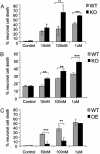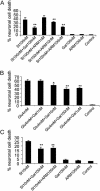Galanin acts as a neuroprotective factor to the hippocampus
- PMID: 15041741
- PMCID: PMC387381
- DOI: 10.1073/pnas.0304823101
Galanin acts as a neuroprotective factor to the hippocampus
Abstract
The expression of the neuropeptide galanin is markedly up-regulated in many areas of the central and peripheral nervous system after injury. We have recently demonstrated that peripheral sensory neurons depend on galanin for neurite extension after injury, mediated by activation of the second galanin receptor subtype (GALR2). We therefore hypothesized that galanin might also act in a similar manner in the CNS, reducing cell death in hippocampal models of excitotoxicity. Here we report that galanin acts an endogenous neuroprotective factor to the hippocampus in a number of in vivo and in vitro models of injury. Kainate-induced hippocampal cell death was greater in both the CA1 and CA3 regions of galanin knockout animals than in WT controls. Similarly, exposure to glutamate or staurosporine induced significantly more neuronal cell death in galanin knockout organotypic and dispersed primary hippocampal cultures than in WT controls. Conversely, less cell death was observed in the hippocampus of galanin overexpressing transgenic animals after kainate injection and in organotypic cultures after exposure to staurosporine. Further, exogenous galanin or the previously described high-affinity GALR2 agonist, both reduced cell death when coadministered with glutamate or staurosporine in WT cultures. These results demonstrate that galanin acts an endogenous neuroprotective factor to the hippocampus and imply that a galanin agonist might have therapeutic uses in some forms of brain injury.
Figures





Similar articles
-
Activation of the galanin receptor 2 (GalR2) protects the hippocampus from neuronal damage.J Neurochem. 2007 Feb;100(3):780-9. doi: 10.1111/j.1471-4159.2006.04239.x. J Neurochem. 2007. PMID: 17263796 Free PMC article.
-
Endogenous galanin protects mouse hippocampal neurons against amyloid toxicity in vitro via activation of galanin receptor-2.J Alzheimers Dis. 2011;25(3):455-62. doi: 10.3233/JAD-2011-110011. J Alzheimers Dis. 2011. PMID: 21471641 Free PMC article.
-
Galanin acts as a trophic factor to the central and peripheral nervous systems.Exp Suppl. 2010;102:25-38. doi: 10.1007/978-3-0346-0228-0_3. Exp Suppl. 2010. PMID: 21299059 Review.
-
Galanin acts as a trophic factor to the central and peripheral nervous systems.Cell Mol Life Sci. 2008 Jun;65(12):1806-12. doi: 10.1007/s00018-008-8154-7. Cell Mol Life Sci. 2008. PMID: 18500646 Free PMC article. Review.
-
Sensory neuronal phenotype in galanin receptor 2 knockout mice: focus on dorsal root ganglion neurone development and pain behaviour.Eur J Neurosci. 2006 Feb;23(3):627-36. doi: 10.1111/j.1460-9568.2006.04593.x. Eur J Neurosci. 2006. PMID: 16487144
Cited by
-
Galanin and its receptors in neurological disorders.Neuromolecular Med. 2005;7(1-2):157-80. doi: 10.1385/NMM:7:1-2:157. Neuromolecular Med. 2005. PMID: 16052044 Review.
-
Methods of Measuring Enzyme Activity Ex Vivo and In Vivo.Annu Rev Anal Chem (Palo Alto Calif). 2018 Jun 12;11(1):509-533. doi: 10.1146/annurev-anchem-061417-125619. Epub 2018 Mar 5. Annu Rev Anal Chem (Palo Alto Calif). 2018. PMID: 29505726 Free PMC article. Review.
-
Multifaceted role of galanin in brain excitability.Elife. 2025 Jul 4;13:RP98634. doi: 10.7554/eLife.98634. Elife. 2025. PMID: 40613532 Free PMC article.
-
Electroosmotic push-pull perfusion: description and application to qualitative analysis of the hydrolysis of exogenous galanin in organotypic hippocampal slice cultures.ACS Chem Neurosci. 2013 May 15;4(5):838-48. doi: 10.1021/cn400082d. Epub 2013 Apr 30. ACS Chem Neurosci. 2013. PMID: 23614879 Free PMC article.
-
Involvement of Neuropeptide Galanin Receptors 2 and 3 in Learning, Memory and Anxiety in Aging Mice.Molecules. 2021 Apr 1;26(7):1978. doi: 10.3390/molecules26071978. Molecules. 2021. PMID: 33915732 Free PMC article.
References
-
- Tatemoto, K., Rokaeus, A., Jornvall, H., McDonald, T. J. & Mutt, V. (1983) FEBS Lett. 164, 124-128. - PubMed
-
- Misane, I., Razani, H., Wang, F. H., Jansson, A., Fuxe, K. & Ogren, S. O. (1998) Eur. J. Neurosci. 10, 1230-1240. - PubMed
-
- Pieribone, V. A., Xu, Z. Q., Zhang, X., Grillner, S., Bartfai, T. & Hokfelt, T. (1995) Neuroscience 64, 861-874. - PubMed
-
- Hokfelt, T., Xu, Z. Q., Shi, T. J., Holmberg, K. & Zhang, X. (1998) Ann. N.Y. Acad. Sci. 863, 252-263. - PubMed
Publication types
MeSH terms
Substances
Grants and funding
LinkOut - more resources
Full Text Sources
Other Literature Sources
Molecular Biology Databases
Miscellaneous

